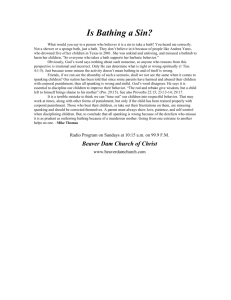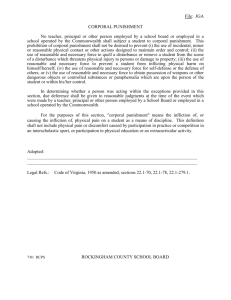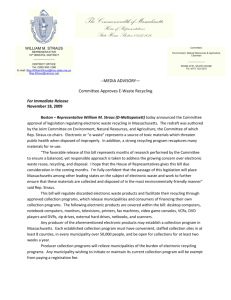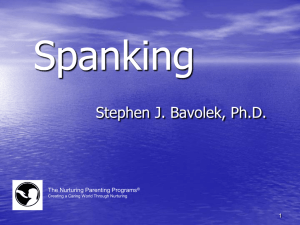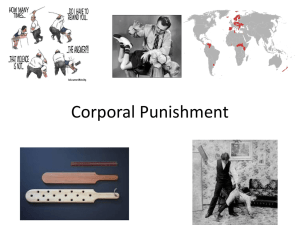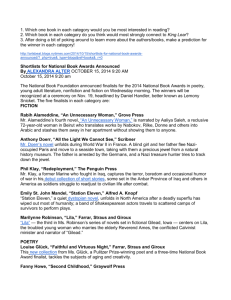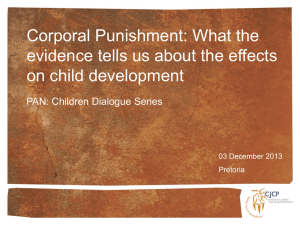review01
advertisement
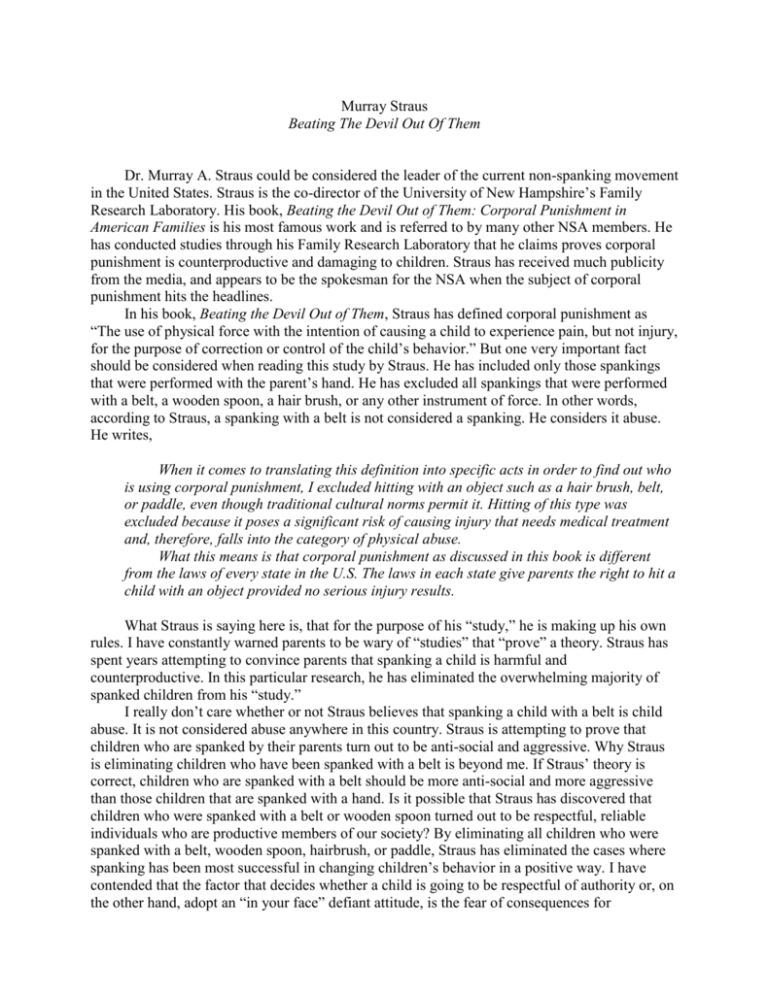
Murray Straus Beating The Devil Out Of Them Dr. Murray A. Straus could be considered the leader of the current non-spanking movement in the United States. Straus is the co-director of the University of New Hampshire’s Family Research Laboratory. His book, Beating the Devil Out of Them: Corporal Punishment in American Families is his most famous work and is referred to by many other NSA members. He has conducted studies through his Family Research Laboratory that he claims proves corporal punishment is counterproductive and damaging to children. Straus has received much publicity from the media, and appears to be the spokesman for the NSA when the subject of corporal punishment hits the headlines. In his book, Beating the Devil Out of Them, Straus has defined corporal punishment as “The use of physical force with the intention of causing a child to experience pain, but not injury, for the purpose of correction or control of the child’s behavior.” But one very important fact should be considered when reading this study by Straus. He has included only those spankings that were performed with the parent’s hand. He has excluded all spankings that were performed with a belt, a wooden spoon, a hair brush, or any other instrument of force. In other words, according to Straus, a spanking with a belt is not considered a spanking. He considers it abuse. He writes, When it comes to translating this definition into specific acts in order to find out who is using corporal punishment, I excluded hitting with an object such as a hair brush, belt, or paddle, even though traditional cultural norms permit it. Hitting of this type was excluded because it poses a significant risk of causing injury that needs medical treatment and, therefore, falls into the category of physical abuse. What this means is that corporal punishment as discussed in this book is different from the laws of every state in the U.S. The laws in each state give parents the right to hit a child with an object provided no serious injury results. What Straus is saying here is, that for the purpose of his “study,” he is making up his own rules. I have constantly warned parents to be wary of “studies” that “prove” a theory. Straus has spent years attempting to convince parents that spanking a child is harmful and counterproductive. In this particular research, he has eliminated the overwhelming majority of spanked children from his “study.” I really don’t care whether or not Straus believes that spanking a child with a belt is child abuse. It is not considered abuse anywhere in this country. Straus is attempting to prove that children who are spanked by their parents turn out to be anti-social and aggressive. Why Straus is eliminating children who have been spanked with a belt is beyond me. If Straus’ theory is correct, children who are spanked with a belt should be more anti-social and more aggressive than those children that are spanked with a hand. Is it possible that Straus has discovered that children who were spanked with a belt or wooden spoon turned out to be respectful, reliable individuals who are productive members of our society? By eliminating all children who were spanked with a belt, wooden spoon, hairbrush, or paddle, Straus has eliminated the cases where spanking has been most successful in changing children’s behavior in a positive way. I have contended that the factor that decides whether a child is going to be respectful of authority or, on the other hand, adopt an “in your face” defiant attitude, is the fear of consequences for wrongdoing. I’ve had other people tell me that what made them respect their father’s authority, was “hearing the leather coming out of dad’s belt loops!” I’m not saying that a spanking with the hand is not effective. I am saying that a spanking with an instrument of force, “the rod,” is more effective. In fact, other child rearing experts believe that the hand should not be used to administer a spanking. Dr. James Dobson, in his book The Strong Willed Child advises that spankings should always be administered with a neutral object, like a switch or a belt. Dr. Dobson feels that the hand should be seen by the child as an object of affection rather than an instrument of punishment. So right off the bat, we have a study, conducted by a so called expert on corporal punishment, that is seriously flawed. The book, Beating the Devil Out Of Them, is not the only published material by Straus that contains corrupted data. In the years since Straus’ book was published in 1994, Straus has continued to make up his own rules when compiling data for his research. In 1997, Straus’ Family Research Laboratory released a study that indicated “when parents use corporal punishment to reduce [antisocial behavior], the long term effect tends to be the opposite.” Conducted by Murray Straus and Nancy Asdigian, this study further proclaims Straus’ claim that corporal punishment is counterproductive and causes irreparable damage to children. In fact, the researchers suggest that if parents were to quit spanking their children altogether, the overall level of violence in our society would be reduced. The problem with this study is, again, the data that was used to reach such a conclusion. According to Dr. Den Trumbull, a Montgomery Alabama pediatrician who is very vocal and supportive of corporal punishment, the findings in Straus’ study are extremely questionable. To begin with, the information was gathered over the telephone by the U.S. Bureau of Labor Statistics, starting in 1979. A total of 807 mothers were asked questions about their methods of disciplining their children. The ages of the mothers who participated in this survey ranged from 14 to 21 years old. As Michael Lemonick states in the August 25, 1997 Time magazine article Spare the Rod? Maybe, “That is hardly a representative slice of American motherhood.” The article also points out that the children involved in this telephone survey ranged in ages from 6 to 9 year olds. According to Trumbull, “more sophisticated studies have consistently shown that corporal punishment is effective and not harmful to long-term development if it is confined to youngsters between 18 months and 6 years.” We have no idea in Straus’ study if the 9 year old children surveyed had been disciplined from the toddler stage, or whether a young confused mother just occasionally smacked her child out of frustration. The same mothers were contacted two years later to determine how the children had fared since the last contact. Straus makes the claim that the children who were spanked by their parents had become increasingly antisocial. Straus also left out other very important factors in his study. In an article in the August 1997 Archives of Pediatrics & Adolescent Medicine, it is revealed “Because many of the children were living with both parents, a more complete measure would require obtaining the same data from fathers. However, the NLSY-CS did not conduct interviews with the fathers, nor did it ask the mothers about spanking by the father or other caregivers.” In other words, if there was a father in the family who was the primary disciplinarian, that factor was not taken into consideration. A child could be spanked by dad, but because mom was not the parent who actually performed the discipline, the child was counted as a non-spanked child. Dad may have spanked the child, resulting in a positive change in the child’s behavior. Straus’ research shows the child was not spanked by mom, yet better behaved. The fact that Straus eliminated this very important factor from his study places more doubt on the accuracy of his findings. So we have concluded that there are enough questions about the manner in which Straus conducts his research to cast some serious doubt on his findings. This is why I caution parents not to believe everything they read simply because the publication states “research has shown.” In his book, Straus is quick to take a swipe at the Bible. In fact, the title of the book, Beating the Devil Out of Them, is the author’s way of poking fun at the Biblical approach to child rearing and the sinful nature of man. The very first paragraph in the book states, “Beating the devil out of him” is just a hyperbola for spanking. Not long ago it also had a religious meaning based on the ideas of original sin and being possessed by the devil. Even today, the idea of a child being possessed by the devil has probably crossed the mind of parents because all children misbehave. Some misbehave more than others, but all children sometimes fail to do what a parent wants or do things that the parent does not want. Many parents now believe in a modern version of original sin - the willful or stubborn child. I don’t believe parents actually feel that their willful child is actually possessed by Satan or a demon. Straus’ unfamiliarity with scripture prevents him from realizing that this term stems from the concept that man is born with a sinful nature. That nature originated in the Garden of Eden, when Eve, and then Adam, were deceived by Satan and partook of the forbidden fruit. Since that time, the sinful nature acquired by Adam and Eve has been passed on to each generation. Straus fails to realize that the phrase he has used for his book is used to describe the method to drive the defiance and stubbornness, caused by the sinful nature, from the child’s personality. As we have discussed earlier, Proverbs 22:15 states “Foolishness is bound in the heart of a child; but the rod of correction shall drive it far from him.” The original Hebrew word for “foolishness” is “ivveleth” (pronounced “iv-veh'-leth”) which means “folly.” Folly, a byproduct of the sinful nature, is bound in the child’s heart. How is it removed? “The rod of correction shall drive it far from him.” The parent is instructed to “beat the devil out of him.” I wonder if anyone has informed Straus that the phrase he is mocking originated from an instruction from God. Straus’ ignorance of Biblical truths was most evident in August of 1997 when I had the opportunity to debate him in front of a national audience on MS-NBC. The producers of the show had invited myself and Straus to appear the day following the release of Straus’ study indicating that spanking was harmful to children. The producer kept the show objective and allowed equal time to those who agreed and disagreed with Straus’ theory. I have always felt that the Bible is an excellent guide to everyday living. If there is a question about how we should conduct our lives, the answer is in the Bible. Considering that fact, I quoted Proverbs 29:15 while on the air, “The rod and reproof give wisdom, but a child left to himself bringeth his mother to shame.” Straus, in an attempt to discredit God’s word, stated “It’s interesting that you didn’t quote Leviticus, which says that if a child talks back to his parents, he should be stoned to death.” At that point, it was evident how little Straus knew about the scriptures. The passage Straus meant to use as his argument that the Bible is unreliable is actually located in Deuteronomy chapter twenty one. In addition to not knowing how to “rightly divide” the word of truth, Straus didn’t even know where the words were located. Certain words convey certain ideas. Straus is careful to use the word “spank” as little as possible, and to use the word “hit” as much as possible. We all know that spanking is generally used in the context of a parent disciplining a child. When we talk about hitting, we understand that the term is used to describe the use of force, one against another. Spanking always involves hitting. Hitting is not always spanking. In our culture, spanking is accepted as a form of discipline and is legal in every state in the country. Hitting is not always acceptable and is outlawed in many circumstances. If I was conducting a study on corporal punishment, I would choose to use the term “spanking.” Straus has decided to use the term “hitting.” To give you a better chance to understand this method of deception by Straus, I have included all of the sentences in chapter four of his book that use the terms “attack,” “hitting,” or “hit” when describing spanking. I have excluded long portions of some of those sentences in order to preserve space, but you will get the general idea. There is no doubt that almost all American children are hit by their parents at some point. Most toddlers are hit several times a week. Physical attacks by parents. How deeply ingrained hitting children is in American culture. Although hitting children is nearly universal. How severe the attacks are. Increasingly ineffective pattern of hitting. Hitting with belts and hair brushes. Continue hitting until the child moves. Frequency, severity, and duration of hitting children. Children are likely to be hit. How often parents hit children. That may culminate in hitting a child. How often parents hit their children. Even require parents to hit children. Parents who had never hit their child. By hitting them if necessary. Morally obligated to hit children. Why so many children are hit. The more likely the parent is to hit a teenager. Almost all American children are fated to be hit by their parents. Increased amounts of approval of hitting a 12-year-old. The child was hit by the parent. The probability of hitting a four-year-old. Almost all parents hit four-year-old children. Whether a child actually will be hit. Hitting a 12-year-old child is never necessary. Chance of actually hitting their 16-year-old. Somewhat more likely to be hit. Much more likely to be hit. Majority of children are still hit. Parents are less likely to hit children. Culturally legitimate hitting of children. More likely to hit children. Mothers hit children more. A mother would hit a one-year-old child. Fathers hit almost as often. The rate of hitting by fathers. Older parents hit much less often. A third more likely to hit. Again more likely to hit. A higher rate of hitting children. Parents of children age four hit them. These percentages of parents who hit. Parents who were hit when they were adolescents. Actually hitting children. Their own parents had hit them. Parents were hit by their parents. Those who were hit the most. Mothers who were hit the most. For mothers who were not hit. Mothers who were hit the most. More likely to hit their children. More likely to hit their children. More likely to hit a child. A parent hitting a four-year-old. Probability of hitting older children. Almost all parents hit toddlers. Probability of a child being hit. More likely to hit children. Probability of hitting children. Are more likely to be hit. Almost all parents hit toddlers. To hit their children. Likely to also hit their children. Much hitting of children. Almost all parents hit toddlers. Emotional high from hitting children. Hitting a child who misbehaves. Shows that hitting children. In this one chapter of Straus’ book, he uses the term “hit,” “hitting,” or “attacks” seventy times when describing a simple spanking. But this should come as no surprise. Straus warns his readers that he is using these term for a reason. In chapter one, he writes, I use the term corporal punishment rather than physical punishment because it more specifically indicates what is involved - an attack on the child’s body. Spanking, hitting, and, occasionally, physical attack and physical assault will be used as synonyms. One objection to using terms such as hit and physically attacked is that they have a negative connotation. That is certainly correct, and in fact it is one of the reasons for using those terms. To take this unfair impression one step further, Straus tries to compare spanking a child with an employer physically assaulting an employee. He writes, To illustrate the extent of the problem, imagine a study called the National Secretary Survey. Suppose that study found that more than 90 percent of secretaries had been hit by their bosses. Suppose the National Officer Managers’ Association challenged the study by pointing out that the punishment was almost all during the first year or two on the job and that in any case, this sort of thing was done only when the secretary would not listen to reason, and it usually happened once or twice a year. There would be a national outcry. But there is no outrage at the downplaying of studies showing that almost all American children are hit by their parents. Can you believe that Straus could equate a parent disciplining a young child with an employer hitting a secretary? Is Straus really unable to understand the difference between the parent/child relationship and the employer/employee relationship? A parent is responsible for the upbringing of the child. A boss is not responsible for the upbringing of his employee. A child can’t quit the family. An employee can quit her job. A parent can’t fire their child. A boss can fire the employee. The attempt to equate a man’s secretary and his child is rediculous. Straus has spent a considerable amount of time promoting the claim that there is a correlation between the murder rate in a given state and the use of corporal punishment in the public school system. Since that time, others in the non-spanking movement have picked up on this theory and have added it to their itinerary of anti-spanking rhetoric. In Beating the Devil Out of Them, Straus attempts to explain this apparent correlation with the use of charts. One extremely simplistic chart shows an apparent increase in “Homicide per hundred thousand,” the line running from the number six up to the number ten. Along the bottom is the “Corporal Punishment Index,” running from the one to the number four. It is apparent by looking at this chart that as the alleged corporal punishement index increases, the homicide rate increases. He writes, States in which teachers are allowed to hit children have a higher rate of student violence and a higher murder rate. The solid line in Chart 7-7 is the 1980 murder rate for the state as a whole. It shows that the more hitting of children that is permitted in the schools of a state, the higher the state’s murder rate. Corporal punishment in schools is an example of using violence to correct a problem, and so are most murders. About 60 percent of murders occur as part of a dispute or argument (Federal Bureau of Investigation, 1988). Both corporal punishment in schools and murders reflect an underlying culture of violence. If the set of underlying cultural and social characteristics reflected in Chart 7-7 help to maintain and reinforce each other, that is immensely important. It suggests that one way to eventually reduce the murder rate is to reduce as many legitimate uses of violence as possible, including corporal punishment of children. Since Straus developed this alleged “correlation,” it has been one of the major arguments the NSA uses to promote the elimination of spanking in our society. Randy Cox, the spokesman for The No Spank web page, states “The homicide rate has decreased 2 1/2 fold in those American states that have abolished corporal punishment in their schools. Statistics also prove that vandalism is less at schools in America where corporal punishment is banned.” It appears that as this theory gains the attention of the anti-spanking bunch, the figures involved continue to climb in favor of the non-spanking side. Once and for all, we are going to put this seriously flawed theory to rest. Straus claims to have obtained his information from the Federal Bureau of Investigation, so we will use the F.B.I.’s statistics to dispute his claim. The murder rate in the United States is shown in two catagories. The first is the total number of murders per year in each state. These figures are difficult to compare, as 2000 murders in the state of New York would appear to be equal to 2000 murders in the state of North Dakota. Because the population of North Dakota is well below the population of New York, 2000 murders in North Dakota would indicate a more severe problem due to the much larger murder rate “per capita.” The second figure supplied by the F.B.I. provides a more accurate picture of the crime rate in each state. The second figure is the “Rate per 100,000 inhabitants.” Straus does not supply his readers with a list of states that have outlawed spanking in the schools and those that still allow the practice. But there are plenty of other sources that can provide one with that information. According to the web site, www.stophitting.com, there are twenty seven states that have banned corporal punishment in the public school systems. They are Alaska, California, Connecticut, Hawaii, Illinois, Iowa, Maine, Maryland, Massachusetts, Michigan, Minnesota, Montana, Nebraska, Nevada, New Hampshire, New Jersey, New York, North Dakota, Oregon, Rhode Island, South Dakota, Utah, Vermont, Virginia, Washington, West Virginia, and Wisconsin. In the remaining twenty three states, there are no laws that outlaw the practice. But this doesn’t mean that students are spanked in the schools in those states. There are states where the state school board has prohibitted such practice and students are not spanked even though the law in that state allows corporal punishment to be used by school personnel. This presents another major flaw in Straus’ “states that have banned spanking in the schools” theory. I went to great lengths to compile the statistics from all fifty states and to divide them into the “spanking allowed” and “spanking banned” catagories. Straus contends that the “spanking allowed” states show a higher murder rate than the “spanking banned” states. Although the twenty seven banned states do show a slightly lower rate of murders than the remaining twenty three, to claim that spanking is the cause of more murders is ludicrous. I’ll explain why. The national average of murders committed in the United States from 1987 through 1998 is 6.46 murders per 100,000 people, per year. Translated into total numbers, the average number of murders in this county each year is about 3,233. If we take each state, one by one, and attempt to correlate corporal punishment in the schools with an increased murder rate, one will see how rediculous this theory is. For instance, the state of New York is listed as a “banned spanking” state, yet it’s murder rate over the ten year period is 10.86 per 100,000 inhabitants, well over the national average. If outlawing spanking in the school system reduces the murder rate, what happened to New York? In the other direction, Wyoming is a state that is listed as allowing spanking in the schools, but its murder rate is only 3.47 per 100,000 inhabitants, almost one half of the national average. If states that allow spanking in the schools are contributing to the murder rate, what happened in Wyoming? The NSA will contend that because North Dakota has banned spanking in its schools, the murder rate has dropped to 1.32 per 100,000 people, yet the murder rate in North Dakota has always been extremely low, and the reason has nothing to do with corporal punishment being banned in the schools. The murder rate was low before spanking was banned. In fact, the murder rate in North Dakota has risen steadily over the past twenty years, much like the rest of the country. The NSA will also attempt to correlate the Louisiana murder rate of 16.03 per 100,000 people with the fact that spanking is allowed in the schools, when spanking has nothing to do with that state’s extremely high murder rate. Murray Straus, Randy Cox, and others who promote this theory, do so simply because thay have discovered a correlating statistic that they believe will substantiate their theory that spanking causes children to grow up violent. It seems to be acceptable for Strause to manipulate figures to fit his agenda, but when someone who promotes corporal punishment points out a “correlation” that supports the theory that spanking a child makes them better behaved, the NSA replies by stating, “You seem to be using correlation non-scientifically. You are, perhaps, describing a process of visually scanning data and conjuring up guesses.” I contend that this is the very method the NSA is using to reach their conclusions. Straus is big on the theory that spanking a child will escalate into serious physical child abuse. His “escalation” theory is flawed for several reasons, but we will first examine why he believes that a spanking parent will eventually become a punching parent. He writes, Clinical work with abusive parents has shown that much physical abuse starts as an attempt to correct and control through corporal punishment. When the child does not comply or, in the case of older children, hits back and curses the parent, the resulting frustration and rage leads some parents to increase the severity of the physical attack and kick, punch, or hit with an object. Kempe and Kempe (1978), for example say: [Abusive parents] . . . may be discouraged when spanking obviously brings no result, but they truly see no alternative and grow depressed both by their own behavior and their babies responses. Helplessly, they continue in the same vicious circle: punishment, deteriorating relationship, frustration, and further punishment. There are two things wrong with this theory. First, the author claims that spanking “obviously brings no result.” There are many child rearing experts who disagree with this claim. My experiences with my own children and those I deal with on the police department dispel this claim. Spanking does bring results. It creates a fear factor that is necessary in a child to produce compliance. I have a real hard time believing that a child who has been spanked for defiance “hits back and curses the parent.” The fact that this child is physically assaulting the parent is strong evidence that he/she has never been spanked. The second strong argument against Straus’ escalation theory is the country of Sweden. As I mentioned in the introduction, Sweden outlawed spanking in 1979. In the years following that ban, serious child abuse cases in that country increase by more than 400 percent! The NSA is quick to avoid this statistic, but the results are in. Reducing spanking in our society does not reduce the cases of child abuse. In fact, it increases the risk that a child will eventually be abused by the parent. Why? For the very reason Straus so eloquently stated. If a child is never spanked when he/she is young, by the time that child reaches teenage years, there is no fear of the parent. The child then thinks they can “hit back and curse” mom or dad. The parent, obviously realizing that the child is stepping way over the line, retaliates, more often with force that would not be necessary with a more compliant child. Admit it, if your fourteen year old is punching you in the face, are you going to use whatever force is necessary to overcome the aggression? If you don’t, you could end up in the emergency room. The force you may need to restrain your defiant teen may very well cross the line into the category of abuse. I believe that is what is happening in Sweden! Straus describes the change in attitude towards spanking as a “moral passage.” He writes, A social problem exists when people come to believe that some state of affairs is morally indefensible and needs to be changed (Spector and Kitsuse, 1977). The situation may have existed for hundreds or thousands of years, but since it was not defined as a social problem, people did not consider it wrong. Corporal punishment illustrates this principle. Children have been hit since the dawn of history and it has not been considered a social problem. But we are now starting to experience what Gusfield (1963, 1981) calls a “moral passage.” Although the pace of change has been slow and there are some counter trends, spanking and other forms of corporal punishment are being redefined more and more as a social problem. There are a number of signs that the moral evaluation of hitting children is changing. The most dramatic change occurred in 1979, when Sweden became the first country to make spanking children illegal. The movement has since spread to the rest of Scandinavia, with Finland following in 1984, Denmark in 1986, and Norway in 1987. Austria followed in 1989. In 1985, the Council of Europe recommended that its member nations limit or prohibit corporal punishment by parents. In 1989, several major organizations adopted position statements opposing corporal punishment by parents, including Parents Anonymous, the National Committee to Prevent Child Abuse, the National Foster Parent Association, the National Association of School Psychologists, and the National Association of Social Workers. In 1992, Division 37 of the American Psychological Association established a task force charged with encouraging research on corporal punishment and with drafting a resolution that, would put the association on record as opposing corporal punishment by parents. The American Academy of Pediatrics created a similar task force in 1991. In 1992, the national Kiwanis organization purchased copies of a video tape called “Spanking - What To Do Instead” (Bavolek, 1992) and encouraged local chapters to show it. This indicates that the idea of bringing up children without hitting is starting to take hold outside of academic life. There is at least one other important sign of change - the ending of corporal punishment in public schools. In 1979, only four of the 50 U.S. states prohibited corporal punishment in the schools. By 1989, the number of states prohibiting corporal punishment in schools had grown to 19, and by 1993 to 25. Except for the trend to prohibit hitting children in schools, none of the changes just listed is by itself momentous. I suggest that together they mark the beginning of a social trend - a moral passage in which behavior that previously was expected of parents is becoming reprehensible. If such a moral passage is in progress, the question is why it is occuring at this point in history. What are the underlying historical and social forces? Are these forces likely to continue and, if so, what does that suggest for the future? I am not going to go into much detail describing Straus’ theory as to why our present culture is experiencing this so called “moral passage.” He details his ideas concerning the reasons for this “new enlightenment” in a section titled “Social Changes Underlying the Moral Passage.” In this chapter, he discusses such things as the “Expansion of Human Rights,” along with the “Transition to a Post-Industrial Economy.” and the “Legitimating Role of Social Science.” Most of this portion of the book is pure psycho-babble. Like most other theories in the world of psychology, it is all speculation and liberal doctrine, none of which has made our society a better place in which to live.
